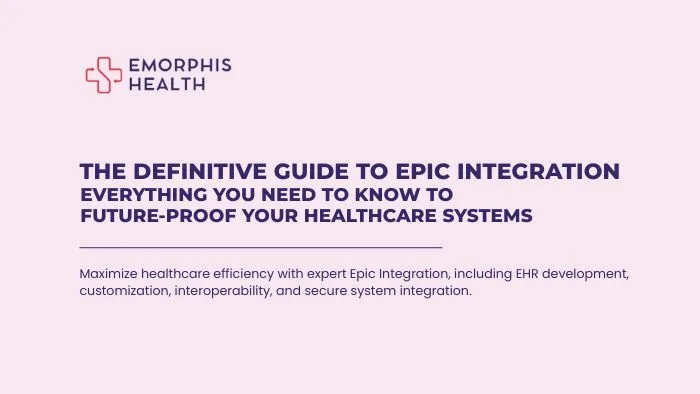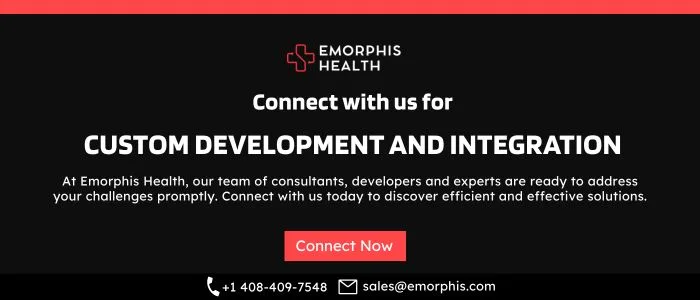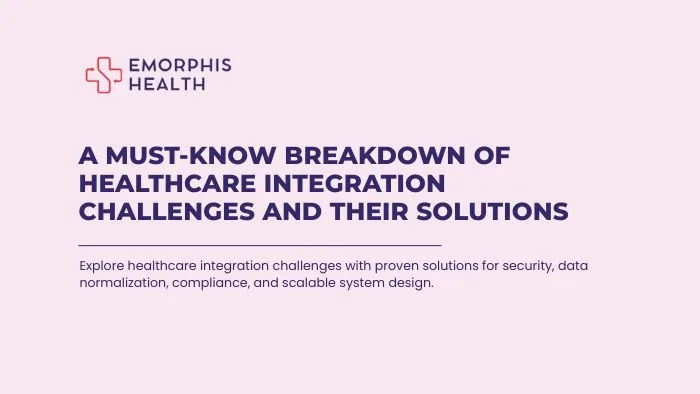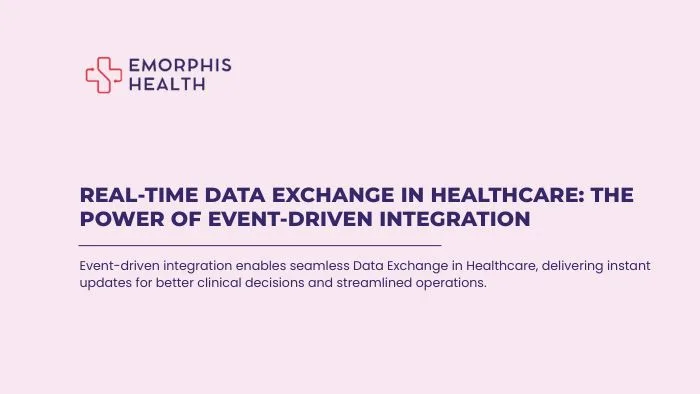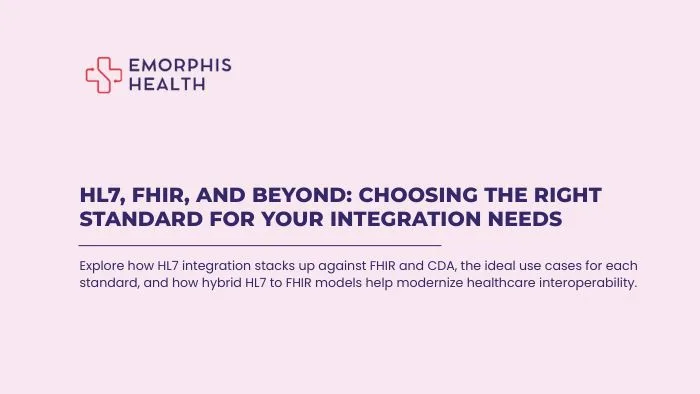Introduction: Why Epic Integration Matters More Than Ever in 2025
See Contents
- 1 Introduction: Why Epic Integration Matters More Than Ever in 2025
- 2 What is Epic Integration?
- 3 Why Epic Integration is not just a technical need but a business-critical strategy for healthcare organizations?
- 4 Common Use Cases for Epic Integration in Modern Healthcare
- 5 How Epic Integration Works: Technical Foundations
- 6 Overcoming Challenges in Epic Integration: Risks, Solutions, and Best Practices for Success
- 7 Addressing Challenges Proactively is Key to Successful Epic Integration
- 8 Ensuring Successful Epic Integration: Challenges, Solutions, and the Role of Expert Partners
- 9 Conclusion: Why Epic Integration is Non-Negotiable for Future-Ready Healthcare Organizations
Healthcare is rapidly evolving in 2025. The pressure on hospitals, clinics, and healthcare providers to deliver more efficient, compliant, and patient-centric services is higher than ever. In this digital era, Electronic Health Records (EHR) systems like Epic have become the backbone of healthcare organizations worldwide. However, merely having an Epic EHR system is no longer enough. The real competitive advantage lies in Epic Integration.
Epic Integration refers to the process of connecting Epic’s EHR with other critical healthcare platforms and systems to enable seamless data flow and interoperability. It ensures that healthcare organizations maximize the potential of their Epic investments while meeting modern operational and clinical demands. This definitive guide explains everything you need to know about Epic Integration, why it is critical, and how it can help future-proof your healthcare systems.
What is Epic Integration?
Epic Integration is the practice of connecting Epic’s EHR platform with a variety of healthcare applications, systems, and technologies to create a unified and interoperable digital health ecosystem. It ensures data flows securely and efficiently between Epic and other third-party systems such as laboratory information systems, radiology systems, telehealth platforms, billing solutions, CRMs, and patient engagement tools.
At its core, Epic Integration enables healthcare providers to break down data silos, improve operational efficiencies, and deliver coordinated care across multiple touchpoints. Without integration, Epic remains a powerful but isolated system. Through integration, it becomes the central hub of your healthcare digital strategy, driving value across clinical, financial, and operational domains.
Unlike standard EHR integrations, Epic Integration requires expertise in Epic’s proprietary APIs, compliance with healthcare data standards like HL7 and FHIR, and a deep understanding of healthcare workflows. Successful Epic Integration is the key to unlocking the full potential of your EHR investment.
Why Epic Integration is not just a technical need but a business-critical strategy for healthcare organizations?
Epic Integration offers far more than a technical advantage. It is a strategic investment that delivers tangible business benefits across the entire healthcare ecosystem. From operational efficiency to financial sustainability and improved patient outcomes, Epic Integration is shaping the future of healthcare organizations.
1. Driving Operational Efficiency Through Epic Integration
One of the most immediate and noticeable impacts of Epic Integration is the improvement in operational efficiency. In healthcare environments where time is critical and accuracy is non-negotiable, having disconnected systems leads to duplicated efforts, manual data entry, and administrative bottlenecks.
With Epic Integration, these inefficiencies are eliminated. Systems communicate seamlessly, data flows automatically, and processes are streamlined. Clinicians and administrative teams no longer need to toggle between multiple platforms or manually reconcile information. Instead, Epic Integration provides a centralized, reliable source of patient data.
This unified approach significantly reduces the risk of human error and ensures that healthcare providers have timely access to the most up-to-date information necessary for delivering quality care.
2. Enhancing Patient Experience Through Seamless Data Exchange
Patient experience has become a key differentiator for healthcare providers. Modern patients expect convenience, transparency, and personalized care. Epic Integration plays a critical role in meeting these expectations by enabling seamless data exchange across systems.
When Epic Integration is properly implemented, appointments, medical histories, test results, and treatment plans are all connected in real-time. This eliminates gaps in information that can cause delays, confusion, or suboptimal care decisions. Patients experience smoother transitions between services, faster diagnoses, and more coordinated care, which enhances trust and satisfaction.
Integrated patient engagement tools also allow organizations to improve communication, follow-ups, and education, further strengthening the overall patient relationship.
3. Unlocking Financial Performance and Revenue Optimization
Financial health is just as important as clinical excellence in today’s competitive healthcare landscape. Epic Integration contributes directly to improving revenue cycle management and financial performance. By integrating Epic with billing systems, claims management solutions, and financial analytics platforms, healthcare organizations can reduce claim denials, accelerate reimbursements, and improve cash flow.
Epic Integration ensures that patient data is accurate and complete when it reaches the billing department, reducing the need for rework and minimizing errors that lead to rejected claims. Furthermore, integrated reporting tools provide detailed insights into revenue trends, operational costs, and financial performance, empowering organizations to make informed business decisions.
Through Epic Integration, healthcare providers achieve a more stable and predictable financial foundation, which supports future growth and innovation.
4. Supporting Regulatory Compliance and Data Security Standards
The healthcare industry operates within one of the most stringent regulatory environments. Compliance with standards like HIPAA, GDPR, HL7, and FHIR is non-negotiable. Epic Integration helps healthcare organizations maintain compliance by enabling secure and standardized data exchange across systems.
Properly implemented Epic Integration reduces the risks associated with data breaches, unauthorized access, and information silos. It ensures that data governance policies are enforced uniformly across all integrated platforms, thereby safeguarding patient privacy and organizational reputation.
Moreover, as regulatory requirements continue to evolve, having a robust Epic Integration strategy in place allows healthcare organizations to adapt quickly and remain compliant without significant disruption.
5. Improving Clinical Decision-Making with Unified Data
High-quality care depends on access to high-quality data. Epic Integration supports better clinical decision-making by consolidating patient information from various sources into one centralized system. This means healthcare providers can access comprehensive patient records that include lab results, imaging reports, medication histories, and specialist notes all in one place.
Such integration empowers clinicians to make faster, more accurate decisions, reduces the risk of adverse events caused by incomplete information, and enhances collaboration across multidisciplinary teams. Epic Integration transforms fragmented data into actionable insights, directly improving care quality and patient outcomes.
6. Positioning for Future Growth and Innovation
Healthcare technology is evolving rapidly, and organizations that invest in Epic Integration today are better positioned to leverage future innovations. Whether adopting AI-powered diagnostics, predictive analytics, remote patient monitoring, or advanced telehealth capabilities, Epic Integration lays the groundwork for a flexible, scalable digital infrastructure.
Integration ensures that new technologies can be added to the ecosystem without disruption, allowing organizations to stay agile and competitive. In an industry where adaptability is crucial, Epic Integration is a proactive step toward long-term sustainability and leadership.
For any healthcare organization looking to optimize operations, enhance patient satisfaction, improve financial outcomes, and maintain regulatory compliance, Epic Integration is no longer optional. It is an essential investment for sustainable success in the modern healthcare landscape.


Common Use Cases for Epic Integration in Modern Healthcare
Epic Integration is widely adopted across healthcare ecosystems to ensure seamless data exchange, streamlined operations, and improved clinical outcomes. Below are some of the most impactful and practical use cases.
a. Integration with Telehealth Platforms
Integrating Epic with telehealth solutions enables real-time synchronization of patient data, virtual visit details, clinical notes, and follow-up instructions, ensuring continuity and quality of care during and after virtual consultations.
b. Integration with Lab Systems and Medical Devices
Epic Integration with laboratory information systems (LIS) and medical devices ensures automated, accurate, and timely transmission of diagnostic results and vitals directly into the patient’s EHR, supporting faster clinical decisions.
c. Integration with CRMs and Patient Engagement Platforms
Connecting Epic with CRM tools enhances patient engagement through automated appointment reminders, follow-up communications, personalized health content, and streamlined patient support services.
d. Integration with Billing and Financial Systems
Epic Integration simplifies financial workflows by linking with billing, claims processing, and revenue cycle management systems, reducing denials, accelerating reimbursements, and improving financial transparency.
e. Integration with AI and Analytics Platforms
Integration with AI and analytics platforms enables organizations to unlock insights for population health, predictive modeling, operational efficiency, and informed strategic planning through Epic’s unified data ecosystem.
f. Integration with Radiology and Imaging Systems
Connecting radiology and imaging solutions to Epic allows healthcare providers to access imaging reports and diagnostics directly within the EHR, improving diagnostic workflows and care coordination.
g. Integration with Pharmacy Management Systems
Epic Integration with pharmacy solutions ensures accurate prescription management, medication tracking, and reduced errors in medication reconciliation processes.
h. Integration with Health Information Exchanges (HIEs)
Connecting Epic to HIEs enhances data sharing across organizations, regions, and care networks, promoting interoperability and facilitating coordinated care delivery.
i. Integration with Wearables and Remote Monitoring Devices
Integrating Epic with wearables and remote patient monitoring devices allows real-time health metrics to flow directly into the EHR, supporting proactive care and chronic disease management.
j. Integration with Scheduling and Referral Management Platforms
Epic Integration streamlines referral processes and appointment scheduling through automated systems that enhance patient access and reduce administrative overhead.
k. Integration with Clinical Research and Trial Platforms
Connecting Epic with research platforms enables easier recruitment, data sharing, and tracking for clinical trials, supporting innovation and advancing medical knowledge.
l. Integration with Workforce Management Systems
Integrating with HR and workforce management platforms supports optimized staffing, credentialing, and compliance management through shared data systems.
Understanding the value of Epic Integration is only the first step. To fully appreciate its impact, it is essential to explore how Epic Integration works and the technical foundations that make it possible.
How Epic Integration Works: Technical Foundations
Epic Integration functions on a sophisticated technical architecture specifically designed to support interoperability, security, and compliance within the highly regulated healthcare environment. It connects various healthcare systems through industry-standard protocols, robust APIs, and structured workflows that enable seamless data flow across platforms. Understanding these foundational elements is crucial for any healthcare organization looking to implement or expand its Epic Integration strategy successfully.
1. Epic APIs: The Core Connectors in Epic Integration
At the heart of Epic Integration lies Epic’s comprehensive suite of APIs. These APIs serve as the technical bridges that facilitate secure and structured communication between Epic’s Electronic Health Record system and other healthcare technologies.
Key APIs include:
-
FHIR (Fast Healthcare Interoperability Resources): FHIR is a modern, web-based standard designed specifically for healthcare interoperability. Epic’s FHIR APIs allow systems to retrieve, update, and exchange healthcare data in a structured and standardized format.
-
HL7 (Health Level 7): HL7 is a long-standing standard in healthcare data exchange. Epic supports HL7 interfaces that enable communication between diverse healthcare applications, such as laboratory systems, imaging platforms, and billing systems.
-
SMART on FHIR: This technology layer allows developers to build applications that integrate securely with Epic, leveraging existing FHIR resources while adding authentication, authorization, and user context layers. SMART on FHIR is widely used for extending Epic’s functionality through third-party apps without compromising security.
These APIs ensure data integrity, maintain security protocols, and support seamless interoperability across platforms, making them central to any successful Epic Integration initiative.
2. Data Standards: Ensuring Consistency, Accuracy, and Compliance
Epic Integration leverages well-established healthcare data standards to maintain the consistency and accuracy of information exchanged between systems. These standards also play a pivotal role in ensuring compliance with regulatory frameworks such as HIPAA, GDPR, and other data privacy laws governing healthcare data.
HL7 and FHIR remain the most widely adopted standards, both of which provide structured guidelines for how data should be formatted, exchanged, and interpreted. Through adherence to these protocols, Epic Integration ensures that disparate systems understand and process data consistently, reducing errors, duplication, and mismatches across the healthcare continuum.
These standards also enable Epic Integration to support future scalability, as new healthcare technologies and platforms continue to adopt these frameworks for interoperability.
3. Workflows: Mapping Technology to Real-World Healthcare Operations
Successful Epic Integration is not solely a technical achievement. It must be intricately aligned with real-world clinical and operational workflows to deliver meaningful value. Integration should enhance, not disrupt, the day-to-day activities of healthcare professionals and administrators.
Examples of workflow-driven integrations include:
- Laboratory Results Integration: Lab information systems feed results directly into Epic, reducing manual entry and ensuring clinicians have timely access to critical diagnostic data.
- Telehealth Data Integration: Virtual care platforms automatically update patient records within Epic, maintaining continuity between remote consultations and in-person care.
- Billing Integration: Financial systems communicate seamlessly with Epic to ensure charges, claims, and payments are processed efficiently and accurately.
These workflows are carefully mapped during the planning phase to ensure that Epic Integration complements and enhances operational efficiency rather than creating additional complexity.
4. The Importance of Planning, Testing, and Validation
Epic Integration is a complex undertaking that requires thorough planning, meticulous testing, and continuous validation to achieve optimal outcomes. Healthcare organizations must follow a structured approach to integration that includes:
- Assessment of Existing Systems: Evaluate current infrastructure, workflows, and integration needs.
- Technical Strategy Development: Define integration points, select appropriate APIs, and establish data governance protocols.
- Rigorous Testing: Conduct extensive testing to ensure secure, accurate, and reliable data flow.
- Validation and Monitoring: Implement ongoing validation processes and performance monitoring to maintain the integrity and efficiency of the integration over time.
Proper execution of these steps ensures that all connected systems communicate flawlessly and securely, supporting clinical excellence, operational efficiency, and regulatory compliance.
Overcoming Challenges in Epic Integration: Risks, Solutions, and Best Practices for Success
While the benefits of Epic Integration are well recognized across the healthcare industry, achieving a seamless, secure, and scalable integration is not without its challenges. Healthcare organizations must be prepared to navigate these complexities strategically. Success depends on understanding the potential pitfalls and proactively applying industry best practices throughout the integration process.
This section provides a detailed exploration of the common challenges associated with Epic Integration, paired with actionable best practices to overcome them and set your integration project up for long-term success.
1. Security and Privacy Compliance: Safeguarding Sensitive Healthcare Data
Healthcare data is among the most sensitive and heavily regulated types of information. Epic Integration must comply with strict privacy and security regulations, including HIPAA, GDPR, and other national and international standards governing health information exchange.
Common Challenges:
- Managing secure data transmission between Epic and external systems.
- Ensuring end-to-end encryption and access controls.
- Maintaining audit trails for compliance reporting.
Best Practices to Overcome:
- Work exclusively with experienced Epic Integration partners who understand healthcare compliance requirements.
- Implement robust security frameworks aligned with HIPAA and GDPR from the outset.
- Ensure that all APIs, endpoints, and data storage solutions meet industry security standards.
- Regularly conduct security audits and vulnerability assessments.
2. Data Governance: Ensuring Accuracy, Consistency, and Accountability
Effective Epic Integration demands strong data governance practices to maintain the integrity of data across connected systems. Inconsistent, inaccurate, or incomplete data can disrupt clinical workflows, impact patient care, and lead to compliance risks.
Common Challenges:
- Data duplication and inconsistencies between systems.
- Lack of clear data ownership and accountability.
- Difficulty in maintaining data integrity across multiple integration points.
Best Practices to Overcome:
- Establish clear data governance policies, including ownership, stewardship, and quality control processes.
- Define and enforce data standards across all integrated platforms.
- Utilize Epic Integration solutions that offer strong validation, mapping, and reconciliation tools.
- Monitor data flows continuously to detect and resolve anomalies quickly.
3. Legacy Systems Compatibility: Bridging the Gap Between Old and New Technologies
Many healthcare organizations rely on legacy systems that were not designed with modern interoperability in mind. Integrating these systems with Epic can be technically challenging and resource-intensive.
Common Challenges:
- Outdated systems lacking modern API capabilities.
- Proprietary data formats incompatible with Epic’s standards.
- Increased risk of data loss or corruption during integration.
Best Practices to Overcome:
- Conduct a thorough assessment of existing systems before planning integration.
- Leverage middleware solutions or custom APIs to bridge compatibility gaps.
- Prioritize integrations that deliver the most immediate operational value while planning phased upgrades for outdated systems.
- Collaborate with vendors experienced in integrating legacy healthcare technologies with Epic EHR.
4. Organizational Resistance: Navigating Change Management in Healthcare Settings
Successful Epic Integration is not solely a technical achievement; it requires alignment across people, processes, and technology. Resistance from clinical or administrative teams can undermine integration efforts if change management is not handled effectively.
Common Challenges:
- Lack of stakeholder buy-in or understanding of the integration’s value.
- Fear of disruption to existing workflows.
- Inadequate communication or training during the integration process.
Best Practices to Overcome:
- Engage key stakeholders from clinical, operational, and IT departments early in the planning process.
- Clearly articulate the strategic benefits of Epic Integration to all impacted teams.
- Provide comprehensive training and support to ensure a smooth transition.
- Foster a culture of collaboration and continuous improvement.
5. Defining Clear Goals and KPIs: Aligning Integration with Business Objectives
Without clearly defined objectives, Epic Integration projects risk losing direction and failing to deliver expected outcomes.
Best Practices to Overcome:
- Set specific, measurable, achievable, relevant, and time-bound (SMART) goals for the integration project.
- Align integration efforts with broader organizational objectives such as improved patient outcomes, operational efficiency, or financial performance.
- Establish KPIs to measure success at each stage of the project lifecycle.
- Use these KPIs to drive accountability and continuous improvement.
6. Choosing Experienced Epic Integration Consultants: Reducing Risk and Enhancing Outcomes
The complexity of Epic Integration requires specialized expertise. Choosing the right partner can significantly impact the success, speed, and security of your integration initiative.
Best Practices to Overcome:
- Partner with consultants or vendors who have proven experience with Epic Integration across various healthcare environments.
- Evaluate their track record, case studies, and client references.
- Ensure they understand both the technical and operational nuances of healthcare interoperability.
7. Adopting Agile Implementation Models: Ensuring Flexibility and Responsiveness
Large-scale integration projects can quickly become unwieldy without a structured yet flexible implementation approach.
Best Practices to Overcome:
- Break down the integration project into manageable phases with clear milestones.
- Use agile methodologies to allow for iterative development, testing, and refinement.
- Incorporate feedback loops to adapt to evolving organizational needs or unforeseen challenges.
- Prioritize high-impact integrations first to deliver early wins and build momentum.
8. Continuous Monitoring and Optimization: Sustaining Long-Term Success
Integration does not end at go-live. Ongoing monitoring and optimization are crucial to maintaining performance, security, and alignment with business objectives.
Best Practices to Overcome:
- Implement continuous monitoring systems to track integration performance in real-time.
- Regularly review integration outcomes against defined KPIs.
- Proactively identify and resolve emerging issues to prevent disruptions.
- Continuously optimize workflows as organizational needs and technologies evolve.
Addressing Challenges Proactively is Key to Successful Epic Integration
Epic Integration offers transformative potential, but success is never automatic. Healthcare organizations must approach integration with a clear understanding of the potential pitfalls and a firm commitment to industry best practices. From security and governance to stakeholder engagement and continuous improvement, each element plays a vital role in ensuring that Epic Integration delivers the intended benefits of operational efficiency, improved patient outcomes, regulatory compliance, and financial sustainability.
Organizations that anticipate challenges and adopt proactive, strategic solutions will not only achieve successful integration but will position themselves as leaders in the future of connected, patient-centric healthcare.
Ensuring Successful Epic Integration: Challenges, Solutions, and the Role of Expert Partners
Achieving successful Epic Integration requires more than just technical connections between systems. It involves navigating common challenges such as data security, privacy compliance, data governance, compatibility with legacy systems, and organizational resistance. These hurdles can impact timelines, budgets, and outcomes if not addressed through a well-planned strategy.
To overcome these challenges, healthcare organizations should follow proven best practices, from defining clear goals and KPIs to engaging stakeholders early, adopting agile implementation methods, and ensuring continuous monitoring post-integration.
One of the most critical success factors is choosing the right integration partner. Emorphis Health stands as a trusted expert in EHR and EMR integration services, with specialized experience in Epic Integration. With deep capabilities in healthcare product development, system integration, and customization, Emorphis Health helps organizations achieve seamless interoperability, enhance operational efficiency, and ensure compliance with healthcare data standards. Their tailored solutions reduce risks, optimize performance, and drive long-term value from EHR and EMR investments.
By partnering with experienced providers like Emorphis Health, healthcare organizations can confidently overcome integration challenges and fully realize the transformative potential of Epic Integration in delivering connected, patient-centered care.
Conclusion: Why Epic Integration is Non-Negotiable for Future-Ready Healthcare Organizations
Epic Integration is no longer a technical upgrade. It is a strategic imperative for healthcare organizations aiming to remain competitive, compliant, and patient-focused. By investing in Epic Integration, healthcare providers unlock the full value of their EHR systems, streamline operations, enhance patient experiences, and position themselves for long-term success in a rapidly evolving industry.
If your organization is serious about future-proofing healthcare systems, there is no smarter investment than Epic Integration today.

